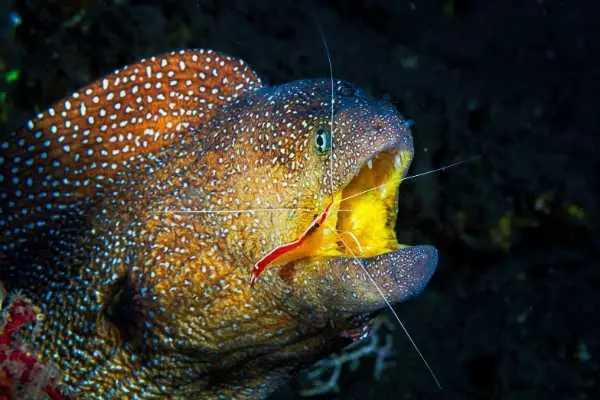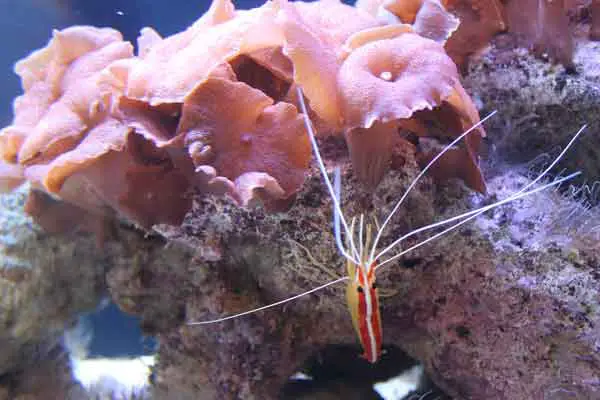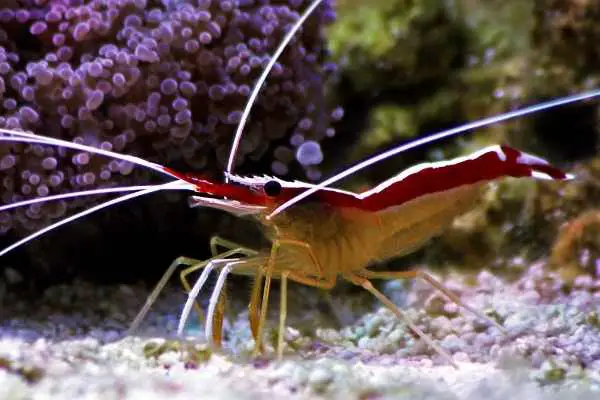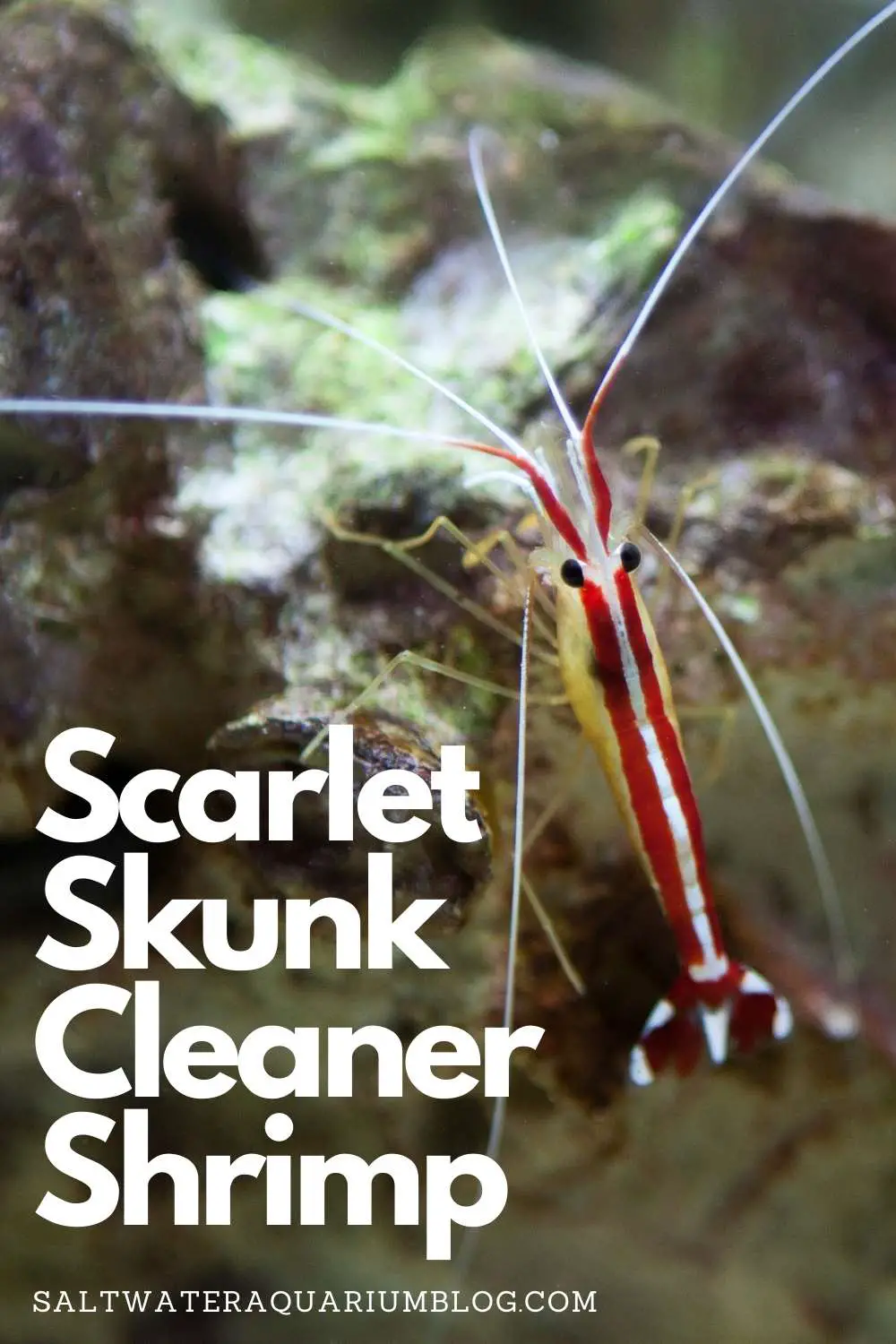While the name, Scarlet Skunk cleaner shrimp might sound like one of the smelliest and least interesting things you could add to your tank, I can assure you, there is nothing ordinary…or smelly…about them. It is by far the most popular of the aquarium cleaner shrimps, despite the unattractive name.
I think the Scarlet Skunk Cleaner Shrimp Association of America (SSCSAA) should take out a marketing campaign to re-brand these amazing invertebrates because their name doesn’t do them justice.
They don’t look or smell like this:
They are gorgeous. Take a look:

or maybe I should just start using either the Latin/scientific name or one of the other less common, common names like lysmata amboinensis, is also commonly known as the scarlet skunk cleaner shrimp, ornamental cleaner shrimp, or white striped cleaner shrimp.
Isn’t it interesting, though, that any animal with a dorsal white stripe is a skunk? Including this one:

And this one

Caring for the Scarlet skunk cleaner shrimp in a reef aquarium
Since the Scarlet Skunk cleaner shrimp is a reef invertebrate, it needs are nearly the same as most reef species; a temperature between 72 and 78 degrees Fahrenheit, a dKH of 8-12, pH between 8.1 and 8.4, and a specific gravity between 1.023 and 1.025. Like all shrimps, specific gravity is especially important, as these shrimps cannot tolerate as wide a range of salinity as most fish. Owners who are lax about monitoring levels, or aquarium setups prone to swings in parameters may not do well with a skunk cleaner shrimp or any crustaceans for that matter.

Native to the Indo-pacific reefs, this charming shrimp is well known by all the reef’s inhabitants. With its yellow body, bright red and white stripes, and long, stark white antennae, this shrimp is a walking advertisement for its fish scrubbing service, and fish happily seek out this shrimp for a cleaning.
Its behavior on the reef works like a car wash; fish swim to the shrimp’s cleaning station, then the skunk cleaner shrimp climbs on to the fish and works it all over, picking off any parasites or tissue hanging on the fish, and will even clean inside the mouths of larger fish.
Why provide this service? It’s an easy meal, for one.
Also, in exchange for this cleaning, fish generally do not prey on the skunk cleaner shrimp, although it would make an easy meal; its service has earned it virtual immunity from the food chain on the reef. The scarlet skunk cleaner shrimp and its fish customers make up one of the most iconic examples of symbiosis on the reef, and in the whole animal kingdom, for that matter. And this is one of a few amazing symbiotic relationships that you can easily keep and observe in your home aquarium.

Lifespan
A long-lived invertebrate, a skunk cleaner fish may live three years or more.
Acclimation
When you first bring home a scarlet skunk cleaner shrimp, you will need to be very careful to slowly acclimate the shrimp to the conditions of your aquarium. Scarlet skunk cleaner shrimp are very susceptible to shock, so it is recommended that the shrimp be acclimated very slowly by the drip acclimation technique, and this should be executed over the course of an hour or longer.
Reef safe?
They are certainly one of several types of reef safe shrimp. While they have been known to occasionally nip at corals, this is very rare in this particular species. Unlike other reef aquarium species that can be aggressive and territorial when kept with other members of the same (or similar) species, you can certainly keep more than one skunk cleaner shrimp in your tank, as long as you provide sufficient food.
Cleaner shrimps are NOT COMPATIBLE (sorry, I didn’t mean to shout that) with saltwater fish species that eat shrimps. So no hawkfish, pufferfish, flame cardinalfish (I found that out the hard way).

Reasons to add a Scarlet Skunk Cleaner Shrimp to your tank
You could certainly have a reef aquarium without adding a skunk cleaner shrimp, but there are a few reasons to add a skunk cleaner shrimp to your tank today:
- They are amazingly delicate, graceful, beautiful creatures
- It is fun to observe the cleaner behavior in your tank as they pick parasites off your saltwater aquarium fish
- Might help ease aggression in the tank

Larval development
Starting from an egg, the immature scarlet skunk cleaner shrimp subsequently goes through fourteen unique larval stages before assuming an adult form. At each stage, the developing larvae feed on different food sources provided by the natural ocean habitat- a difficult environment to recreate in captivity. But even then, it’s transformations are not complete. All skunk cleaner shrimp are male. That is, they all start out as males. Over the course of several molts as an adult form, the skunk cleaner shrimp eventually becomes a hermaphrodite in its most mature state. This complex development means you aren’t likely to be successful in breeding skunk cleaner shrimp at home.

For more information
A handy reference for learning about the lifecycle of shrimp is:
How to raise & train your peppermint shrimp
Yes, I know, that’s a totally different species, the peppermint shrimp, but it’s full of good information, a lot of which is directly applicable to the care of the skunk cleaner shrimp. You might also want to read about a few of the other great shrimp available in the reef aquarium hobby:



Leave a Reply to Nicholas Turner Cancel reply